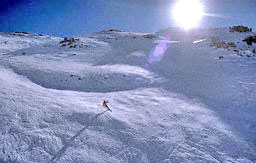|
Chapter One
STAR STONES
"There, on a windswept plain in England about eighty miles southwest
of London, circles of imposing megaliths form the most important
prehistoric monument in the whole of Britain.... The multitudes that
visit the site find that only some of the megaliths still remain
standing, while others have collapsed to the ground or are somehow
gone from the site. But scholars and researchers have been able to
figure out the configuration of the circles-within-circles (which
highlights the still-standing megaliths) and observe the wholes
indicating where two other circles - of stones or perhaps wooden
pegs - had once existed, in earlier phases of Stonehenge.
"....All the studies conclude that the alignments (of
Stonehenge’s
construction) served astronomical purposes, they were first oriented
circa 2900 B.C., (give or take a century or so) to sunrise on the
summer solstice day; and realigned circa 2000 B.C. and then again
circa 1550 B.C. toward sunrise on summer solstice day in those
times.
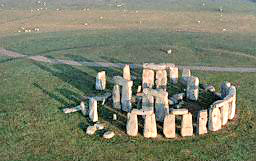 "One of the shortest yet most ferocious recent wars in the Middle
East was the Six Day War of 1967, when the hemmed-in and besieged
Israeli army defeated the armies of Egypt, Jordan, and
Syria and
captured the Sinai peninsula, the West Bank of the Jordan River, and
the Golan Heights. In the years that followed Israeli archaeologists
conducted extensive archaeological surveys and excavations in all
those areas, bringing to light settlements from nearly Neolithic
times through biblical times to Greek, Roman, and Byzantine periods.
Yet nowhere was the surprise greater than on the sparsely inhabited
and mostly empty plateau called the Golan Heights. "One of the shortest yet most ferocious recent wars in the Middle
East was the Six Day War of 1967, when the hemmed-in and besieged
Israeli army defeated the armies of Egypt, Jordan, and
Syria and
captured the Sinai peninsula, the West Bank of the Jordan River, and
the Golan Heights. In the years that followed Israeli archaeologists
conducted extensive archaeological surveys and excavations in all
those areas, bringing to light settlements from nearly Neolithic
times through biblical times to Greek, Roman, and Byzantine periods.
Yet nowhere was the surprise greater than on the sparsely inhabited
and mostly empty plateau called the Golan Heights.
"....Virtually in the middle of nowhere, on the windswept plain
(that had been used by the Israeli army for artillery practice),
piles of stones arranged in circles turned out - when viewed from
the air - to be a Near Eastern "Stonehenge."
|
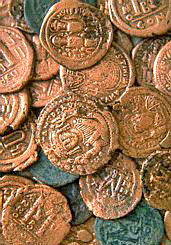 |
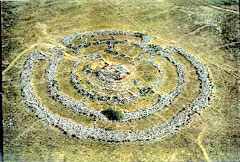
Above:
This Photo by permission of
Israeli UFO Research
Left:
Byzantine Copper Coins found in the Golan Heights in
the excavations |
"Apart from its unique shape, this is by far one of the largest
single stone structure in western Asia, so large in fact that it can
be seen from space by Earth-orbiting spacecraft.
"Engineers who have studied the site estimated that, even in its
present condition, it contains more than 125,000 cubic feet of
stones weighing an aggregate of close to 45,000 tons. They estimated
that it would have taken one hundred workmen at least six years to
create this monument - collect the basalt stones, transport them to
the site, place them according to a preconceived architectural plan,
and raise the walls (undoubtedly taller than the now-visible
remains) to form the cohesive complex structure.
"All of which raises the questions, by whom was this structure
built, when, and for what?
After more discoveries about the orientation of the structure by the
Israeli archaeologists, there were indications:
"....that the place was indeed, as
Stonehenge in Britain, built to
serve as an astronomical observatory (and primarily to determine the
solstices) is reinforced by the existence of such observatories
elsewhere - structures that are even more similar to the one on the
Golan, for they feature not only concentric circles, but also the
radial walls connecting the circles. What is amazing is that those
similar structures are at ancient sites all the way on the other
side of the world in the Americas.
"One is the Mayan site
Chichen Itza in the Yucatan peninsula of
Mexico, nicknamed the Caracol ("Snail") on
account of the winding
stairs inside the observatory’s tower. Another is the circular
observatory atop the promontory of Sacsahuaman in Peru that
overlooks the Inca capital Cuzco; there as at Chichen Itza, there
was probably a lookout tower; its foundations reveal the layout and
astronomical alignments of the structure and clearly show the
concentric circles and connecting radials.
"Such similarities were reason enough for the Israeli scientists to
call in Dr. Anthony Aveni of the USA, an internationally acclaimed
authority on ancient astronomies, especially those of the
pre-Columbian civilizations of the Americas. His task was not only
to confirm the astronomical orientations underlying the design of
the Golan site, but also to help determine its age - and thus, in
addition to the For What question, also answer the question
When.
|

Above:
El Caracol, Chichen Itza
Right:
Sacsahuaman, Cuzco |
 |
More studies by Arthur Posnansky and
Rolf Muller showed:
"....that in order to determine exactly
the angle of Earth’s tilt -
which indicates, when elevation and geographic position are taken
into account, the structure’s age - it is essential to determine
precisely where north is. It is thus undoubtedly significant that in
the case of the Golan site, the researchers there found that the
dominant and on clear days visible peak of Mount Hermon lies
precisely north of the structure’s center. Dr. Aveni and his Israeli
colleagues, Yonathan Mizrachi and Mattanyah Zohar, were thus able to
determine that the site was so oriented as to enable an observer
standing in its center and following a sight line through the center
of the northeastern gateway, to see the Sun rise there on solstice
day on a June dawn at about 3000 B.C.!
Mount Hermon
"By 2000 B.C., the scientists concluded, the
Sun would have appeared
to a similar observer noticeably off-center, but probably still
within the gateway. Five hundred years later, the structure had lost
its value as a precise astronomical observatory. It was, then,
sometimes between 1500 and 1200 B.C. - as confirmed by carbon dating
on small artifacts recovered there - that the central stone heap was
enlarged to form a cairn - a stone mound under which a cavity has
been dug out, probably to serve as a burial chamber.
"Uncannily, these phased dates are virtually identical to the dates
assigned to the three phases of Stonehenge.
"....There was no coffin and no body, nor any other human or animal
remains (in the presumed burial chamber at Golan’s structure) in
either the chamber or antechamber. But the archaeologists did find,
as a result of meticulous sifting of the soil, a few gold earrings,
several beads made of carnelian semiprecious stone, flint blades,
bronze arrowheads, and ceramic shards. They therefore concluded that
indeed it was a burial chamber, but one that had been looted,
probably in antiquity....
"....The finds have been dated to the period known as
Late Bronze
Age, which extended from about 1500 to 1200 B.C. That was the time
frame of the Exodus of the Children of Israel to Egypt under the
leadership of Moses, and the conquest of the Promised Land under the
leadership of Joshua. Of the twelve tribes, the tribes of Reuben and
Gad and half the tribe of Manasseh were alloted parts of
Transjordan,
from the River Arnon in the south of the foothills of Mount Hermon
in the north. Those domains included the mountain range at Gilad
east of the Jordan River and the plateau that is now the Golan. It
was therefore perhaps unavoidable that Israeli researchers turned to
the Bible for an answer to the question: Who?
"According to the
books of Numbers and Joshua, the northern part of
the Gilead mountains was ruled by a king called Og from his capital
of Basham.... Og and all his men took the field against the Children
of Israel.... Winning the battle, the Israelites captured sixty
towns that were "fortified with high walls and gates and barriers,
apart from a great number of unwalled towns." The enigmatic Golan
site - was thus within the capabilities of the kingdoms in the time
of King Og.
"Og, according to the Bible, was a big and stout man: "His iron
bedstead is nine cubits long and four cubits wide" (equivalent to
over thirteen feet and six feet, respectively). This giant size, the
Bible hints, was due to his being a descendant of the Repha’im, a
giant-like race of demigods who had once dwelt in that land. (Other
giantlike descendants of the Repha’im including
Goliath, are
mentioned in the Bible as siding with the Phillistines at the time
of David).
|

David and Goliath
|
 |
"....The Biblical assertions that the area had once been the domain
of the Repha’im and that Og was descended of them are quite
intriguing, because we find the Repha’im and their offspring
mentioned in Canaanite myths and epic tales. The texts, which
clearly place the divine and semidivine actions and events in the
area we are dealing with here, were written on clay tablets
discovered in the 1930s at a coastal site in northern Syria whose
ancient name was Ugarit. The texts describe a group of deities whose
father was El ("God, the Lofty One") and whose affairs centered on
El’s son Ba’al ("the Lord") and his sister
Anat ("She who
answers")....
"....Several of the discovered texts deal with such involvement on
the part of the trio....
"....Another tale, The Legend of King Keret.... concerns the claim
to immortality by Keret because of his divine descent, instead he
falls ill, and his sons wonder aloud: "How could an offspring of
El,
the Merciful One, die? Shall a divine die?" Foreseeing the seemingly
incredible death of a demigod, the sons envision not only the Peak
of Zaphon, but also the Circuit of Broad Span lamenting for
Keret:
For thee, father,
shall weep Zaphon, the Mount of Ba’al.
The sacred circuit, the mighty circuit, the circuit of broad span,
[for thee] shall lament.
"There is here, then, a reference to two highly venerated places
that shall mourn the death of the demigod: Mount Zaphon, the
Mount
of Ba’al - and a renown sacred circular structure - "the sacred
circuit, the mighty circuit, the circuit of broad span." If Mount Zaphon, the "Mount of the North," was
Mount Hermon, which lies
precisely north of the Golan site, was then the Sacred Circuit the
enigmatic Golan site?
"....But being only a demigod,
Keret in the end did die. Was he then
the one buried in the tomb within "the sacred circuit, the mighty
circuit, the circuit of broad span"? Though the Canaanite texts give
no chronological hint, it is evident that they relate events from
the Bronze Age - a time frame that could well fit the date of the
artifacts discovered in the Golan site’s tomb.
"Whether or not any of those legendary rulers ended up being buried
at the Golan site, we may never know for sure.... archaeologists,
they are, however, certain ( based on structural features and
various dating techniques) that the construction of the "henge" -
concentric walls of what we might dub Star Stones because of the
astronomical function - preceded by 1,000 to 1,500 years, the
addition of the cairn and its burial chambers.
"As at
Stonehenge and other megalithic sites, so too regarding
the
Golan site, the enigma of who built them is only intensified by
establishing their age an determining that an advanced knowledge of
astronomy underlay their orientations. Unless they were the divine
beings themselves, who was there capable of the feat - circa 3000
B.C. in the case of the Golan site?
"In 3000 B.C. there was in western Asia only one civilization high
enough, sophisticated enough, and with an extraordinary astronomical
knowledge, capable of planning, orienting astronomically, and
carrying out the kind of major structures here considered: the
Sumerian civilization.... accounted for virtually all the "firsts"
of what we deem essential to a high civilization.... Their calendar,
still in use as the Jewish calendar, was inaugurated in a city
called Nippur in 3760 B.C. - embracing all the sophisticated
knowledge required for the structures we are discussing.
"It was a civilization that preceded that of
Egypt.... Indus
Valley.... Babylonians.... Assyrians.... Hittites.... Elamites....
Cannanites and Phoenicians....
"Did the
Sumerians venture as far as the Golan Heights? Undoubtedly,
for their kings and their merchants went westward toward the
Mediterranean Sea.... the Persian Gulf.... When Ur became their
capital their merchants were familiar in all parts of the Near
East....
Mr. Sitchin at this
point recounts the legend of King Gilgamesh,
which the reader may view from previous writings
HERE
"One of the most recounted episodes in the King’s adventures has
been the incident in which he encountered two ferocious lions,
fought them off, and killed them with his bare hands.... it was a
totally unexpected discovery to find at a site near the concentric
circles, a stone slab with such a depiction....
"....While the textual references and the depiction on the stone
slab do not constitute conclusive evidence that Gilgamesh reached
the site on his journey to the Cedar Mountains of Lebanon, there is
one more intriguing clue to be considered. After the site was
identified from the air, the Israeli archaeologists discovered that
it was marked on (captured) Syrian army maps by the name Rugum el-Hiri
- a most puzzling name, for it meant in Arabic "Stone heap of the
bobcat."
"The explanation for the puzzling name, we suggest, may well lie in
the
Epic of Gilgamesh, reflecting a memory of the
King Who Fought
the Lions.
"And we shall see, that is just the beginning of intricate and
intertwined associations.
Return
Chapter Two
FATE HAS
TWELVE STATIONS
"Scholars have long recognized that in the lore of diverse nations
the same theme, the same basic tale, appears and reappears though
under different guises, names, and localities. It is thus perhaps no
wonder that the carved basalt stone on which Gilgamesh is depicted
fighting with the lions was discovered near a village bearing the
name Eim Samsum - "Samsom’s Spring." For, it will be recalled,
Samsom, also fought and killed a lion with his bare hands. That was
some two thousand years after Gilgamesh, and certainly not on the
Golan Heights. Is the village’s name, then, just a coincidence, or
the lingering memory of a visitor called Gilgamesh becoming
Samsom?
"Of greater significance is the association with King Keret.... it
is presumed by many (e.g. Cyrus H. Gordon Notes on the Legend of Keret) that the combined name for the king and his capital in fact
identified the island of Crete. There, according to Cretan and Greek
legends.... the god Zeus saw Europa, the beautiful daughter of a
king of Phoenicia.... and taking the form of a bull, abducted
her.... he had three sons by her, among them Minos.... He (Minos)
appealed to Poseidon, god of the seas, to bestow upon him a sign of
divine favor.... Poseidon made a Divine Bull.... Minos vowed to
offer the beautiful bull as a sacrifice to the god.... but instead
he kept it to himself.... the god made the king’s wife fall in love
and mate with the bull.... the legendary Minotaur was the
offspring.... Minos then commissioned the divine craftsman Daedalus
to build in the Cretan capital Knossos an underground maze from
which the bull-man would be unable to escape. The maze was called
the Labyrinth.
"....It certainly resembles the layout of the Golan site and it
calls for going back to the Epic of Gilgamesh for the hero’s
encounter with the Bull of Heaven.
The reader may go back to the second book
The Stairway to Heaven and read about the
Epic of Gilgamesh.
Mr. Sitchin continues:
"What was the
Bull of Heaven - GUD.ANNA in Sumerian? Many students
of the Epic.... have come to the conclusion that the Epic’s events,
taking place on Earth, are but a mirror image of events taking place
in Heaven. Utu/Shamash is the Sun, Inanna/Ishtar is what she was
later called in Greek and Roman times - Venus. The menacing
guardian
of the Cedar Mountains with a face of a lion is the constellation of
Leo (the Lion), and the Bull of Heaven the celestial group of stars
that has been called - since Sumerian times! - the constellation of
the Bull (Taurus).
"....The Sumerian zodiacal lists began with
Taurus, which was indeed
the constellation from which the Sun was observed rising at dawn on
the day of spring equinox in the fourth millennium B.C. It was
called in sumerian GUD.ANNA ("Bull of Heaven" or "Heavenly Bull") -
the very same term used in the Epic of Gilgamesh for the divine
creature that Inanna/Ishtar had summoned from the heavens and that
the two comrades slew.
"Did the slaying represent or symbolize
an actual celestial event,
circa 2900 B.C.? While the possibility cannot be ruled out, the
historical record indicates that major events and changes did occur
on Earth at that time; and the "slaying" of the Bull of Heaven
represented an omen, a heavenly omen, predicting or even triggering
events on Earth.
"For the better part of the fourth millennium B.C. the Sumerian
civilization was not only the greatest on Earth, but also the only
one. But circa 3100 B.C. the civilization of the Nile (Egypt and
Nubia) joined the one of the Euphrates-Tigris Rivers.... Egyptian
celestial-zodiacal depictions indeed associated the beginning of
their civilization with the cutting off of the forepart of the
constellation of the Bull.
"As we have detailed in
The Wars of Gods and Men, Inanna/Ishtar had
expected at that time to become mistress of the new civilization,
but it was - literally and symbolically - torn away from her. She
was partly appeased when a third civilization, that of the Indus
Valley, was put under her aegis, circa 2900 B.C.
"....A thousand years after the probable stay of
Gilgamesh at the
Golan site, it was visited by another ancient VIP who also saw Fate
written in the zodiacal constellations. He was Jacob, the grandson
of Abraham; and the time, by our calculations, was about 1900 B.C.
"A question that is often ignored regarding the megalithic
structures around the globe is, Why have they been constructed where
they are....? The great pyramids of Giza, we have suggested in our
writings,
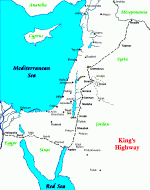 |
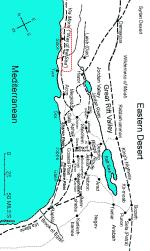 |
served as anchors for a Landing Corridor leading to a
spaceport in the Sinai peninsula.... all on the thirtieth parallel
north.... Stonehenge.... was erected where it is because it is
precisely there that its astronomical functions could combine both
solar and lunar observations.... the Golan Circles connected two
major international routes, the King’s Highway
(click image left) and the
Way of the
Sea
(click image right)
The two routes connected
Mesopotamia and Egypt, Asia and
Africa. At the Golan site, the crossing could be made on either side
of the Sea of Galilee (Lake Kinnereth); the preferred one - then and
now - is the one on the north, where the bridge has retained its
ancient name: The Bridge of the Daughters of Jacob.
"Based on biblical and Mesopotamian data, we believe that this was
what Jacob had used the site for.
"The story began two centuries earlier, in
Sumer, and it began not
with Jacob’s grandfather Abraham but with Jacob’s great
-grandfather, Terah.... The family’s care to be known as
Ibri
(Hebrew) people suggests to us that they considered themselves to be
Nippurians - people from the city Nippur that in Sumerian was
rendered NI.IBRU - "The Beautiful/Pleasant Abode of Crossing."
"....Circa 2100 B.C. Terah was transferred to
Ur.... and then to a
distant city called Harran. Situated on the Upper Euphrates and its
tributaries, the city served as major crossroads and trading post
(which its name, meaning the Caravancy, indicated).... And it was
there that Terah died when he was 205 years old.
"It was after that that
God said unto Abram: "Get thee out of thy
country, and out of thy birthplace, and from thy father’s dwelling
place, unto the land that I will show thee. And Abram took Sarai his
wife.... Lot.... his nephew.... and all the people in their
household, and all of their belongings, and went to the land of
Canaan....
"Acting on divine instructions, Abram moved quickly in Canaan to
establish a base in the Negev.... On a visit to Egypt he was
received in the Pharaoh’s court.... when back in Canaan he played a
role in an international conflict.... It was after that that God
promised Abram a son.... but Sarai remained barren....
"....At her suggestion, her handmaiden,
Hagar, bore Abram a son,
Ishmael.... After the upheaval of Sodom and
Gomorrah when the
couple’s names were changed to Abraham and Sarah, Abraham then aged
one hundred, had a son by his wife.... Isaac. Though not the first
born, was the Legitimate Heir under the Sumerian succession rules
that the Patriarch followed, for he was a son of his father’s half
sister, "the daughter of my father but not of my mother,"
Abraham
said of Sarah (Genesis 20:12).
"It was after the death of
Sarah.... that Abraham.... (137 years by
our calculations) became concerned about his unmarried son Isaac.
Fearing that Isaac would end up marrying a Canaanite, he sent the
overseer of his household to Harran, to find there a bride for
Isaac
from among the relatives that had remained there. Arriving at the
dwelling village of Nahor, he met at the watering well
Rebecca, who
turned out to be Nahor’s graddaughter and ended up going to Canaan
to become Isaac’s wife.
"Twenty years after they got married
Rebecca gave birth to twins,
Esau and Jacob.
|

Rebecca at the Well
|
"Esau was first to get married, taking two wives right off, both of
them Hittite lasses: "They were a source of grief to Isaac and
Rebecca...." So Isaac called Jacob and instructed him to go to
Harran, to his mother’s family, to find there a bride.
"....The Bible reports only one episode (of Jacob’s journey) -
though a very significant one. It was the nighttime vision by
Jacob.... of a stairway to heaven on which Angels of the Lord were
ascending and descending. Awakened, Jacob realized that he had come
upon "a place of the Elohim and a gateway to heaven." He marked the
place by setting up a commemorative stone, and named the site
Beth-El - "The House of El," the Lord. And then, by a route that is
not stated, he continued to Harran.
"On the city’s outskirts he saw shepherds gathering with their
flocks at a well in the fields.... Jacob met Rachel,
Laban’s
daughter who invited him to stay and meet his other daughter, the
older Leah.... but Jacob fell in love with Rachel and offered to
work for seven years in lieu of a dowry.... But on the night of the
wedding, after the banquet, Laban substituted Leah for
Rachel in the
bridal bed.
"When Jacob discovered the bride’s identity....
Laban said, here, we
do not marry off the younger daughter before her elder sister, why
don’t you work another seven years for me and then marry Rachel too?
Jacob did, he married
Rachel and he was very successful in the
fields but this attracted the envy of Laban’s sons.
"And so it was, when
Laban and his sons were away to sheer their
flocks of sheep, that Jacob gathered his wives and children and
flocks and fled Harran. "And he crossed the river" - "the Euphrates"
- and set his course toward the mount of Gile’ad."
"On the third day it was told to
Laban that Jacob had escaped....
after seven days he caught up with him at the mount of Gilead."
"....Gilad - "The Everlasting Stone Heap" in Hebrew - the
site of
the circular observatory in the Golan!
"The encounter started with bitter exchanges and reciprocal
accusations. It ended with a peace treaty.... Jacob selected a stone
and erected it to be a Witnessing Pillar, to mark the boundary
beyond which Laban would not cross into Jacob’s domains nor would
Jacob cross to Laban’s domains. Such boundaries stones, called
Kudurru in Akkadian because of their rounded tops, have been
discovered at various Near Eastern sites.
"....How certain can we be that the place was that of the Golan
circle’s site? Here, we believe, is the convincing final clue: In
his oath of treaty, Jacob also described the site as Ha-Mitzpeh -
The Observatory!
"The Book of Jubilees, an
extrabiblical book that recounted the
biblical tales from varied early sources, added a postcript to the
recorded event: "And Jacob made here a heap for a witness, wherefore
the name for the place is called ’The Heap of Witness’; but before
they used to call the land of Gilead the Land of the Repha’im."
"And thus we are back to the enigmatic Golan site and its nickname
Gilgal Repha’im.
"The Kudurru boundary stones that have been found in the Near East
bore, as a rule, not just the terms of the agreement and the names
of the gods invoked as its guarantors, but also the god’s celestial
symbols - sometimes of the zodiacal constellations - all twelve of
them....
"....While not all the symbols depicting the twelve zodiacal
constellations have survived from Sumerian times, or even Babylonian
times, they have been found on Egyptian monuments, in identical
depictions and names.
"Should any one doubt that Abraham, a son of the astronomer-priest
Terah, was aware of the twelve zodiacal-houses when God told him to
observe the skies and see therein the future....? When his first son
was born by the handmaiden Hagar, God blessed the boy Ishmael ("By
God Heard"), by this prophecy:
As for Ishmael:
Indeed I have heard him.
By this do I bless him:
I will make him fruitful
and I will multiply him exceedingly;
Of him twelve chieftans will be born,
his shall be a great nation.
Genesis 17:20
"With that prophetic blessing, linked to the starry heavens as
observed by Abraham, does the Bible for the first time record the
number twelve and its significance. It then relates (Genesis 25)
that Ishmael’s sons - each a chief of a tribal state - indeed
numbered twelve.
"....The next time the Bible employs the number twelve is in listing
Jacob’s twelve sons at the time when he was back at his father’s
estate in Hebron.... Listing them by the names that later became
familiar as names of the Twelve Tribes of Israel....
Mr. Sitchin gives more examples from biblical source of the
importance of the number twelve and the relationship with the
zodiacal symbols, as with Joseph’ s dreams, and the blessing of the
twelve sons of Jacob.
"Archaeologists excavating the remains of Jewish synagogues in the
Holy Land are sometimes puzzled to find the floors of such
synagogues decorated with the zodiacal circle of twelve
constellations depicted by their traditional symbols. They tend to
view the finds as aberrations from Greek and Roman influences in the
centuries before Christianity. Such an attitude, stemming from the
belief that the practice was prohibited by the Old Testament,
ignores the historical record - the Hebrews’ familiarity with the
zodiacal constellations and their association with predictions of
the future - with Fate.
"For generations and to this day, one can hear cries of
Mazal-tov!
Mazal-tov! at Jewish weddings or when a boy is circumcised. Ask
anyone what it means, and the answer will be "Good Luck," let the
couple or boy have good luck with them.
"Few realize, however, that though that is what is intended, that is
not what the phrase means. Mazal-tov literally means "a good
/favorable zodiacal constellation."
"....The observation of the heavens for fateful indications, a task
performed by a corps of astronomers-priests, assumed a key role in
Babylonian times....
"....Today’s horoscopic astrology’s roots go back well beyond the
Babylonians, the "Chaldeans" of Greek reports. Coupled with the
twelve-month calendar, the notion that Fate and the Zodiac are two
aspects of the same course of events undoubtedly began at least when
the calendar began - in Nippur, in 3760 B.C. (which is when the
count of the Jewish calendar began). That such an association can be
gleaned, in our opinion, from one of the Sumerian constellation
names, that of ZI.BA.AN.NA. The term, understood to mean "Heavenly
Fate" literally means "Life-Decision in the heavens" as well as "The
Heavenly Scales of Life...." In
the Papyrus of Ani, the god
Anubis
is shown weighing the heart (Day of Judgment) in a balance and the
god Thoth, the Divine Scribe recording the result on a pallet.
"An unsolved puzzle in Jewish traditions is why the biblical Lord
had chosen the seventh month, Tishrei, as the month in which the
Hebrew New Year was to begin.... We believe that the crucial clue is
the calendrical link with the zodiac. At the time of the Exodus
(mid-second millennium B.C.) the first constellation, that of the
spring equinox, was Aries, not Taurus anymore. And
starting with
Aries, the constellation of the Heavenly Scales of Life was indeed
the seventh. The month in which the Jewish New Year was to begin,
the month in which it would be decided in heaven who is to live and
who is to die, who is to be healthy or to be sick, to be richer or
poorer, happy or unhappy - was the month that paralleled the
zodiacal month of the Celestial Scales.
"And in the heavens,
Fate had twelve stations."
Return
|
 "One of the shortest yet most ferocious recent wars in the Middle
East was the Six Day War of 1967, when the hemmed-in and besieged
Israeli army defeated the armies of Egypt, Jordan, and
Syria and
captured the Sinai peninsula, the West Bank of the Jordan River, and
the Golan Heights. In the years that followed Israeli archaeologists
conducted extensive archaeological surveys and excavations in all
those areas, bringing to light settlements from nearly Neolithic
times through biblical times to Greek, Roman, and Byzantine periods.
Yet nowhere was the surprise greater than on the sparsely inhabited
and mostly empty plateau called the Golan Heights.
"One of the shortest yet most ferocious recent wars in the Middle
East was the Six Day War of 1967, when the hemmed-in and besieged
Israeli army defeated the armies of Egypt, Jordan, and
Syria and
captured the Sinai peninsula, the West Bank of the Jordan River, and
the Golan Heights. In the years that followed Israeli archaeologists
conducted extensive archaeological surveys and excavations in all
those areas, bringing to light settlements from nearly Neolithic
times through biblical times to Greek, Roman, and Byzantine periods.
Yet nowhere was the surprise greater than on the sparsely inhabited
and mostly empty plateau called the Golan Heights.




